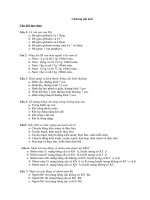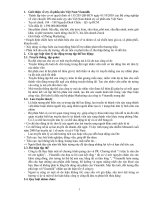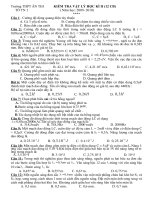tài liệu – page 2 – tâm lý học vb2k04
Bạn đang xem bản rút gọn của tài liệu. Xem và tải ngay bản đầy đủ của tài liệu tại đây (596.62 KB, 8 trang )
<span class='text_page_counter'>(1)</span><div class='page_container' data-page=1>
Cognitive
</div>
<span class='text_page_counter'>(2)</span><div class='page_container' data-page=2>
Keywords
Cognitive formulation – the beliefs and behavioral
strategies that characterize a specific disorder
Conceptualization – understanding of individual
clients and their specific beliefs or patterns of
behavior
Cognitive model –the way that individuals perceive
a situation is more closely connected to their
reaction than the situation itself
Automatic thoughts – an idea that seems to pop
</div>
<span class='text_page_counter'>(3)</span><div class='page_container' data-page=3>
Introduction
CBT is based on the idea that how we think (cognition),
how we feel (emotion) and how we act (behavior) all
interact together. Specifically, our thoughts determine
our feelings and our behavior.
Therefore, negative and unrealistic thoughts can cause
us distress and result in problems. When a person
suffers with psychological distress, the way in which
they interpret situations becomes skewed, which in
turn has a negative impact on the actions they take.
CBT aims to help people become aware of when they
make negative interpretations, and of behavioral
patterns which reinforce the distorted thinking.
</div>
<span class='text_page_counter'>(4)</span><div class='page_container' data-page=4>
Roles of CBT
The cognitive therapist teaches clients how to identify
distorted cognitions through a process of evaluation.
The clients learn to discriminate between their own
thoughts and reality. They learn the influence that
cognition has on their feelings, and they are taught to
recognize observe and monitor their own thoughts.
The behavior part of the therapy involves
setting <b>homework for the client</b> to do (e.g. keeping a
diary of thoughts). The therapist gives the client tasks
that will help them challenge their own irrational beliefs.
The idea is that the client identifies their own unhelpful
</div>
<span class='text_page_counter'>(5)</span><div class='page_container' data-page=5>
ABC Model
<b>A -Activating Event or objective situation.</b> The first
column records the objective situation, that is, an event
that ultimately leads to some type of high emotional
response or negative dysfunctional thinking.
<b>B - Beliefs.</b> In the second column, the client writes down
the negative thoughts that occurred to them.
<b>C - Consequence.</b> The third column is for the negative
feelings and dysfunctional behaviors that ensued. The
negative thoughts of the second column are seen as a
connecting bridge between the situation and the
distressing feelings. The third column C is next explained
by describing emotions or negative thoughts that the
</div>
<span class='text_page_counter'>(6)</span><div class='page_container' data-page=6></div>
<span class='text_page_counter'>(7)</span><div class='page_container' data-page=7>
Cognitive Distortions
<b>Arbitrary interference</b>
: Drawing conclusions
on the basis of sufficient or irrelevant evidence:
for example, thinking you are worthless because
an open air concert you were going to see has
been rained off.
<b>Selective abstraction</b>
: Focusing on a single
aspect of a situation and ignoring others: E.g.,
you feel responsible for your team losing a
football match even though you are just one of
the players on the field.
<b>Magnification</b>
: exaggerating the importance of
undesirable events. E.g., if you scrape a bit of
paint work on your car and, therefore, see
</div>
<span class='text_page_counter'>(8)</span><div class='page_container' data-page=8>
Cognitive Distortion
Minimisation: underplaying the
significance of an event. E.g., you get
praised by your teachers for an
excellent term’s work, but you see this
as trivial.
Overgeneralization: drawing broad
negative conclusions on the basis of a
single insignificant event. E.g., you get
a D for an exam when you normally get
straight As and you, therefore, think
you are stupid.
Personalisation: Attributing the negative
feelings of others to yourself. E.g., your
teacher looks really cross when he
</div>
<!--links-->









